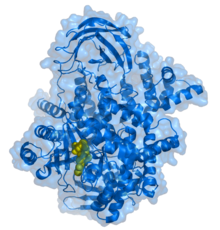Activated PI3K delta syndrome
| Activated PI3K delta syndrome | |
|---|---|
| Other names | immunodeficiency 14, p110δ-activating mutation causing senescent T cells, PASLI |
 | |
| Activated PI3K Delta Syndrome is autosomal dominant | |
| Symptoms | Immunodeficiency, Lymphadenopathy[1] |
| Causes | Mutation in phosphatidylinositol 4,5-bisphosphate 3-kinase catalytic subunit delta isoform[2][3] |
| Diagnostic method | Genetic testing[4] |
| Treatment | Antiviral therapy[5][6] |
Activated PI3K delta syndrome is a primary immunodeficiency disease caused by activating gain of function mutations in the PIK3CD gene.[7][8][2] Which encodes the p110δ catalytic subunit of PI3Kδ, APDS-2 (PASLI-R1) is caused by exon-skipping mutations in PIK3R1 which encodes for the regulatory subunit p85α. APDS and APDS-2 affected individuals present with similar symptoms, which include increased susceptibility to airway infections, bronchiectasis and lymphoproliferation.[medical citation needed]
Symptoms and signs
The signs and symptoms of activated PI3K Delta Syndrome are consistent with the following:[1]
- Immunodeficiency
- Lymphadenopathy
- Sinopulmonary infections
- Bronchiectasis
Cause
In terms of genetics, activated PI3K Delta Syndrome is autosomal dominant, a mutation in phosphatidylinositol 4,5-bisphosphate 3-kinase catalytic subunit delta isoform is the reason for this condition (located at chromosome 1p36.) [2][3]
Mechanism

The pathophysiology of activated PI3K delta syndrome has several aspects.[2] The normal function has P110δ (PI3K) involved in immune system regulation.[9]
P110δ effect is not limited to the immune system; P110δ has a presence in transformed epithelial cells and cell adhesion molecules (airway inflammation), and research has been done on the possibility of P110δ in the nervous system.[10]
Activated PI3K delta syndrome effect indicates affected individuals are likely to have activation-induced cell death.[2] Normally, PI3K-delta signaling assists B cells and T cells to mature; however, overactive PI3K-delta has an effect on the B and T cell differentiation (the process by which cells eventually are different from one another[11]).
Consequently, there is an inability to confront an infection, as well as early cell death. Furthermore, overproduction of said signal can cause lymphadenopathy (which is an enlargement of lymph nodes[12]) due to excess white blood cells.[7]
Diagnosis
In order to ascertain if an individual has activated PI3K delta syndrome, usually one finds atypical levels of immunoglobulins. Methods to determine the condition are the following:[4]
- Genetic testing
- Laboratory findings
- Symptoms exhibited
Treatment

Infections for this condition, are treated or prevented in the following general ways:[5][6]
- Bacterial infection should be treated rapidly (with antibiotics)
- Antiviral therapy
- Modify lifestyle (exposure to pathogens need to be minimized)
See also
References
- ^ a b "PASLI disease | Genetic and Rare Diseases Information Center (GARD) – an NCATS Program". rarediseases.info.nih.gov. Retrieved 2017-06-09.
- ^ a b c d e "OMIM Entry - # 615513 - IMMUNODEFICIENCY 14; IMD14". www.omim.org. Retrieved 2017-06-10.
- ^ a b Reference, Genetics Home. "PIK3CD gene". Genetics Home Reference. Retrieved 2017-06-10.
- ^ a b "PI3 Kinase Disease | NIH: National Institute of Allergy and Infectious Diseases". www.niaid.nih.gov. Retrieved 2017-06-10.
- ^ a b "Immunodeficiency (Primary and Secondary). Information". patient.info. Retrieved 2017-06-11.
- ^ a b "Bronchiectasis Treatment & Management: Approach Considerations, Supportive Treatment, Antibiotic Therapy". 2017-02-17.
{{cite journal}}: Cite journal requires|journal=(help) - ^ a b Reference, Genetics Home. "activated PI3K-delta syndrome". Genetics Home Reference. Retrieved 2017-06-09.
- ^ Collard, Harold R.; Richeldi, Luca (2017-02-18). Interstitial Lung Disease E-Book. Elsevier Health Sciences. p. 9. ISBN 9780323480253.
- ^ "PIK3CD phosphatidylinositol-4,5-bisphosphate 3-kinase catalytic subunit delta [Homo sapiens (human)] - Gene - NCBI". www.ncbi.nlm.nih.gov. Retrieved 2017-06-11.
- ^ Schoenberger, Stephen P.; Katsikis, Peter D.; Pulendran, Bali (2015-08-31). Crossroads Between Innate and Adaptive Immunity V. Springer. p. 121. ISBN 9783319157740.
- ^ Prasad, Keder N. (2012-12-06). Regulation of Differentiation in Mammalian Nerve Cells. Springer Science & Business Media. p. 2. ISBN 9781468481129.
- ^ Fleisher, Gary R.; Ludwig, Stephen (2010). Textbook of Pediatric Emergency Medicine. Lippincott Williams & Wilkins. p. 378. ISBN 9781605471594.
Further reading
- Arjunaraja, Swadhinya; Snow, Andrew L. (2015). "Gain-of-function mutations and immunodeficiency: at a loss for proper tuning of lymphocyte signaling". Current Opinion in Allergy and Clinical Immunology. 15 (6): 533–538. doi:10.1097/ACI.0000000000000217. ISSN 1528-4050. PMC 4672729. PMID 26406182.
- Okkenhaug, Klaus; Ali, Khaled; Vanhaesebroeck, Bart (2007). "Antigen receptor signalling: a distinctive role for the p110δ isoform of PI3K". Trends in Immunology. 28 (2): 80–87. doi:10.1016/j.it.2006.12.007. ISSN 1471-4906. PMC 2358943. PMID 17208518.
